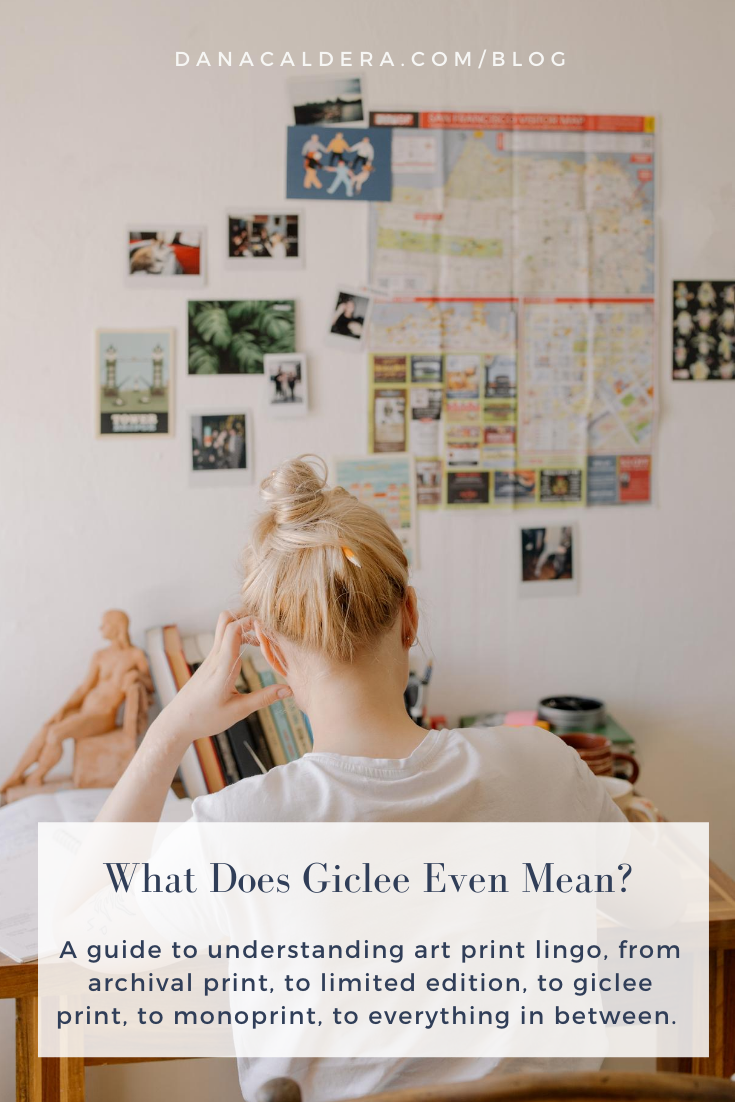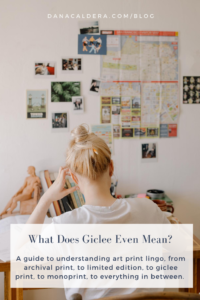Your cart is currently empty!
What Does Giclee Even Mean? A Guide to Understanding Fine Art Prints Lingo

Art prints, fine art prints, giclee prints, archival prints, limited edition prints, monoprints, relief prints, photography prints…I could go on and on. “Prints” is a word we use often in the art world and it can have vastly different meanings. In this blog post I will break down the lingo that artists use to describe fine art prints, and what you should know as an informed collector. Let’s dive in, shall we?
First, there are two main buckets that can be used to describe art prints: reproductions and originals.
Reproductions
Reproductions are what you see most often for sale online or in retail stores. Prints, art prints, fine art prints, giclee prints, or archival prints are all terms used to describe printed reproductions. Putting terms like “art” or “fine art” in front of prints doesn’t necessarily mean anything, but it likely signifies the quality of the print. I use the term “fine art” when I refer to my prints because I am printing giclee prints that are sourced with archival inks and luxurious, archival paper. I also use it to indicate that the original image that is being reproduced was a piece of original fine art.
Archival:
Archival is a broad term that indicates that the artwork is made with materials that are “suitable for long term contact with important objects, safe and stable to museum and library standards” (source). It is important for artwork to be archival, meaning that the art will not yellow or deteriorate over time. It’s recommended that artists and conservators use archival inks, papers, adhesives, and plastics in artwork. You can read more about what archival means for art materials in this informative blog post.
Giclee:
Giclee printing is a term referring to a professionally produced print using inkjet technology with archival inks, archival paper, and color quality control. The word “giclée” comes from the french word for “nozzle” (giclur) because of the wide format spray of the inkjet printing process (source). A giclee print is now considered the standard for high quality fine art printing.
Originals
The term “original art prints” refers to art made with traditional printmaking techniques. These can include, but are not limited to, etchings, lithographs, woodcut, linocut, silkscreens (seriographs), drypoints, collagraph, aquatints, or mezzotints. For each of these prints, the artist has to physically create each print from the matrix. The matrix is the block, screen, or plate that has been carved or etched, so that it holds the image that will be printed. The matrix is usually made by hand.
Printmakers usually create their work in a series where there are a limited number of prints made of the same design. So while each print is technically one-of-a-kind because it is run by hand using a printing press, hand rolled ink, and the matrix, it will be one-of-many prints bearing the same images. Prints made in a series come numbered in this style 1/50, 2/50…50/50, indicating their place in the series. Here is a wonderful resource on how a printmaker should label their series, including proofs and other hand-modified prints.
Monoprints are a unique form of traditional printmaking because they are truly one of a kind. Monoprints or monotypes are typically made when the artist applies ink or paint to a non-porous surface, like plexiglass, and then creates a print from that. Only one print can be pulled using this technique.
Open Edition vs. Limited Edition Art Prints
Artists have the option to create either open edition or limited edition prints. With open edition, the number of prints that can be created and sold are unlimited. Limited edition prints are just that, limited. The artist will select a number of prints for the image and cannot create more prints. This creates a scarcity, and therefore an artist will charge more for a limited edition print (source).
Traditional printmaking series are by default a limited edition. When you see a label like 1/50, 2/50…50/50. Then you know that the size of the edition is 50.
Some caveats to limited edition fine art prints:
Artists can open a new run of limited edition prints of the same image, but they will typically change something, such as the substrate or a color so that the new run of prints is different. Artists will also make prints as part of a limited edition that are called artist’s proofs. There is no limit on the number of artist’s proofs, and they are not counted in the edition total, but they can be sold.
Digital 2D Artwork Prints
The terminology for reproduction prints can be applied to digitally created artwork. The artist can choose to print in an open or limited edition and select the quality of the inks and colors that are used. In this case, the digital file is considered the original work of art.
Photography Art Prints
In fine art photography, an original photograph used to refer to the photograph that was made directly from the negative. However now, with the rise in digital photography, original photographs are more like original prints, where they are printed in series. A photographer may also choose to print their photographs as open edition reproductions. You can read more about original photographs vs. reproductions in this informative blog post.
Thoughts, questions, or comments? Leave them below and I’ll do my best to answer them!
PS. My fine art prints shop is opening on September 5! In the meantime, you can shop originals directly from the studio here.

Comments
3 responses to “What Does Giclee Even Mean? A Guide to Understanding Fine Art Prints Lingo”
Good information, Dana. Unfortunately, so many of these terms have become corrupted (meaning the original definitions have lost their meaning) with the advent of commonplace printing techniques, specifically inkjet printing. For instance, everyone knows that a giclee print or mass-produced lithographic print from an original oil painting is a reproduction because of the absence of brush strokes. But sometimes, like with illustrations and digital art, one can’t really tell if it’s an original or a reproduction. It gets even dicier with original photographs, since nobody limits printing them from “the original digital file.” Point is, the term “reproduction” is meaningless without an artist’s definition of what his/her use of the term means to collectors. Calling a fine art print of a photographic image or digital art “giclee” or “reproduction” without a definition attached can be confusing at best and misleading at worst. For example, research will show that an Ansel Adams “original” is a wet-darkroom analog silver gelatin print. But it can also mean an inkjet “giclee” made from his original negatives under carefully managed conditions of provenance. And, like you describe, an Adams “reproduction” is a mass-produced lithograph or series of inkjets without provenance. So, provenance is the real discriminator between originals and reproductions in the mediums of art photography and digital art, and perhaps provenance means even more with original illustrations and pulled prints. Perhaps a discussion of Certificates of Authenticity would further the topic.
Very good points. Thank you for weighing in. I suppose too, that trust in the artist or gallery is an equally important factor in determining the quality of the print you might buy.
Thank you for the primer, Dana, and yes trust in the gallery or artist does enter into the picture, pun intended. And thanks to J Riley Stewart for his input.